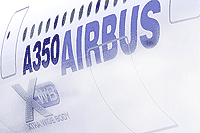By Guy Norris at Farnborough air show
General Electric has ruled out supplying an engine for the largest member of Airbus's revamped A350 Xtra Wide Body (XWB) widebody twinjet family to avoid a conflict with the GE90-powered Boeing 777.
Rolls-Royce has meanwhile struck a preliminary agreement to offer a variant of the Trent engine, while Pratt & Whitney has reiterated its desire to support a solution based on a further development of the GP7200 through the Engine Alliance partnership with GE.
|
|---|
| The new A350 has forced engine makers to rethink |
| AIRBUS A350 XWB |
 |
| Airbus unveiled the A350 Xtra Wide Body at the Farnborough air show. This article is one of a series of articles our team wrote from the show. |
| Farnborough: 350 power race ignites |
| Farnborough: Cautious welcome for new A350 |
| Farnborough: GEnx offered for future A330s |
| Farnborough: Finnair first carrier to commit to new Airbus A350 XWB twinjet family |
| Farnborough: Airbus goes for extra width |
None of the engine makers have received specific technical requirements from Airbus, although the outline thrust needs are based around 75,000lb (334kN) for the A350-800, 87,000lb for the -900 and 95,000lb for the -1000.
R-R engineering and technology director Colin Smith says: "We're in the middle of talks with them. If possible we'd like to do one engine for the whole family."
Smith says the baseline configuration will take elements from other engines such as the Trent 1000 and the conceptual Trent 1700, which was offered for the original A350. "It is feasible with the three-shaft design, and the key for us is whether you can find an engine that does the thrust of the larger aircraft and yet can do the economics of the smaller aircraft."
GEnx programme general manager Tom Brisken says: "The obvious solution is to scale-up the GEnx - that's the leading candidate at this stage."
Aside from the competitive issues, Brisken says: "It's quite a span of thrust between -800 and -1000 and we didn't think it could be done with one engine effectively. When you do a new engine you need two applications. We didn't see any other 95,000lb applications, and that's why it's a tough business case for the -1000."
P&W president Steve Finger says the GP7200 could provide it with the basis for a way back into the Airbus project. "Our priority is to maximise opportunities for engines we already have in place," he says.
Source: Flight International




















